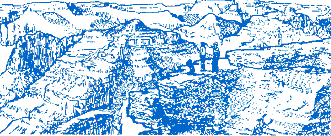

One of the more beautiful areas of the United States is Bryce Canyon. Our cover picture shows a familiar view of this area, but walking amidst the spires and seeing the beauty up close is a unique experience. Bryce Canyon is an area of the United States that has been lifted up to nearly 8,000 feet. Anyone who visits the area with its unique and rugged landscape would be motivated to ask how it got to be the way it is. No place looks quite like this place so the processes and conditions here must be unique.
Similar questions arise when one visits Monument Valley, the Grand Canyon, Petrified Forest, or Devil's Tower. In fact, any where you go in the entire world or in space, you can see sights unique to that area or location.
It is interesting that we frequently see atheist authors and creationist authors giving the same answer to this question. Both say that you either believe that all of these geological phenomena--as well as everything else in the creation--was either created that way by God or it has come about as a product of blind chance. In both camps, there is a prevalent view that all things are either God-designed or chance-designed and that there is no other alternative. It is understandable why atheists would want to make such a narrow choice available. Not only do they push forward their religious view, but they also set up belief in God to be a shallow and inconsistent view of reality. The problem of human suffering and disaster is a much more difficult area to deal with if God is pulling all the strings and making it all happen. Add to this the everyday operations of nature which seem to be chance-driven, and you have belief in God in an illogical box.
It would seem that Bryce Canyon is the ideal place to show the foolishness of forcing only these two choices. Did God sit down and carve each pillar as an artist would a statue? You can stand on the edge of the scene on the front of our journal and you can watch new pillars being formed, so clearly the notion that God directly produced the pillars is not true for all of them at least. Does this mean that chance formation of the environment that produced the columns is the only other option?
From a geologic standpoint, there are a wide variety of factors that are believed to have contributed to the production of Bryce Canyon. When the rocks that make up the Canyon were laid down, they were deposited in a flat area near sea level. The sand and the iron oxide that colors it were deposited in beds that were flat. After many beds were laid down, a new material was deposited that had a complex mineral makeup that made it very hard. After the whole area was covered with several more layers of material, the whole region was lifted up by forces deep within the earth. As water eroded this uplifted area, it found it very hard to cut through the hard material on top; so, once that hard layer was cut through, the water cut deeper and deeper instead of flattening the area. There are many places where hard cap rock produces structures similar to Bryce Canyon so the scenario above is fairly familiar.
Whether the previous paragraph is what really happened in Bryce Canyon or not is not important. The question is whether the scenario we have described precludes God having had any role in the process.
Many times in previous issues of this journal, we have emphasized that the Bible tells us that there are two ways in which God brings about His Will. One way is the performance of a miracle that only God can do. The Hebrew word bara denotes this kind of process and is only used in reference to God's activity--never man's. The second way is that God makes things happen in a natural way with no miraculous act on God's part. The Hebrew word asah indicates this and is often applied to things man can do. At the end of the Genesis account, the author tells us that God used both processes in bringing about the Creation.
These are the things which the Lord God created (bara) and made (asah)--Genesis 2:3
A failure to understand both processes that God uses in bringing things into existence leaves us with many problems in understanding in a variety of areas. God's capacity to heal is not just seen in miracles that defy acts of doctors, but also in the design of the human body, in our mental outlook, in plants and animals that provide us drugs, and in environmental factors. The bad things that happen to us do not happen because "God does it to us," but as a logical result of the struggle between good and evil and what we were created for and as a consequence of what we have individually and collectively done to the environment. War, disease, AIDS, starvation, poverty, etc., are not God-caused, but the result of man's refusal to live as God has told him to.
When we look at life itself, at the cosmos as a whole, and at beautiful places like Bryce Canyon, we are seeing the handiwork of God. The design built into everything from quarks to intergalactic space allows these things to function. Man or God can direct how the process will progress, but the initial design demands an intelligence that makes chance a belief system without credibility.
Note: For a list of physical constants that have to be carefully controlled in the creation process to allow matter to exist at all, send a self-addressed, stamped envelope to John Clayton, 1555 Echo Valley Dr, Niles, MI 49120.
--John N. Clayton
Back to Contents Does God Exist?, May/Jun97.